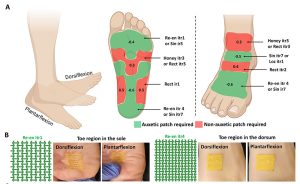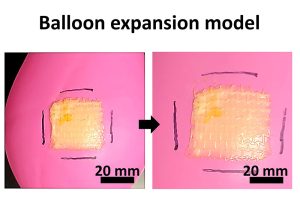Researchers have created a dissolvable, ultra-elastic adhesive patch to deliver therapeutics that promote healing.

From chronic wounds to battlefield triage to heart surgery, this self-sticking bandage is designed to adapt to any body surface, internal or external, creating a bond stronger than current FDA-approved adhesives. The applications of this innovation are detailed in Nature Communications.
“Our patch mimics the skin’s expandability and flexibility, stretching as a person moves,” says principal investigator Juliane Nguyen, professor in the UNC Eshelman School of Pharmacy. “Normal bandages contract in one direction as they expand in another. Ours are designed to expand in both directions, preventing tissue damage and promoting adhesion.”
This unique design — known as an auxetic structure — is 3D-printed and can be specified for the part of the body it will be used on. A bandage used on skin has a different structure than a bandage used on the heart. As preclinical testing, including mice and synthetic skin models, has shown, this design allows the patch to move with even the most dynamic areas, like elbows, feet, or lungs.

“The patches can be printed in minutes,” Nguyen says. “They could potentially be printed as required in a hospital setting and be personalized for an individual’s specific needs.”
And, because they are made from a hydrogel designed to degrade over time, their removal is both pain- and damage-free. Nguyen is working to customize degradation times based on how long the bandage is needed.
“The patches are a promising addition to surgical sutures and staples,” says Tom Egan, a professor of surgery within the UNC School of Medicine and a co-investigator on the study. “By loading therapeutics onto the patch and promoting their controlled release, we can prevent air leaks in lungs or bleeding from the heart.”

Egan specifically studied how the patches can treat puncture wounds or cover staple lines after lung surgery, instances where air leaks might occur and endanger the patient. The patch’s ability to prevent leaks reduces the need for the use of chest tubes — flexible drainage systems that run between the ribs to reach the space just outside of the lungs. This improvement decreases the need for painkillers and creates a better overall patient experience.
“If this material and strategy works, we could perform thoracic surgery through minimally invasive approaches and avoid using traditional surgical methods and devices that can be painful for patients,” Egan says.
To further test the patches, Nguyen will conduct studies with large animals with collaborators at NC State University. She hopes to accelerate healing and improve treatment in diabetic and burn wound patients and explore using the bandages to replace skin grafts in the remodeling of skin tissue.
“As we continue our testing, it’s possible that even more indications will come to light,” Nguyen says.
This project was made possible by the contributions of Parth Chansoria, a former postdoctoral researcher in the Nguyen Lab, and Ameya Chaudhari, a PhD student in the Nguyen Lab, who are co-first authors on the study published in Nature Communications.
Juliane Nguyen is a professor and vice chair of the Division of Pharmacoengineering and Molecular Pharmaceutics in the UNC Eshelman School of Pharmacy. She is also a professor in the Joint Department of Biomedical Engineering and a member of the UNC Lineberger Comprehensive Care Center and the UNC McAllister Heart Institute.
Tom Egan is a professor in the Department of Surgery within the UNC School of Medicine and an adjunct professor in the Joint Department of Biomedical Engineering. He is also a member of the UNC Lineberger Comprehensive Care Center.
